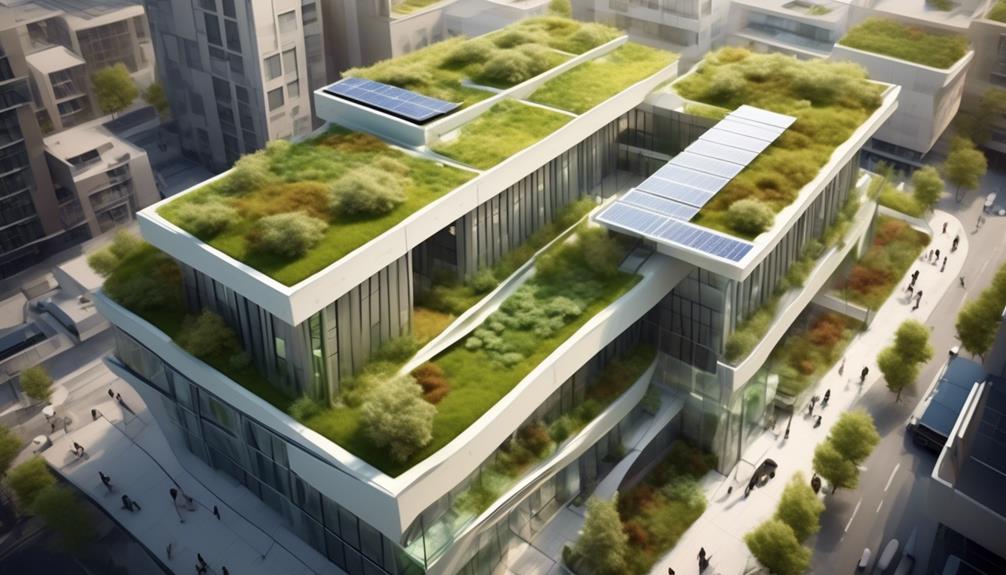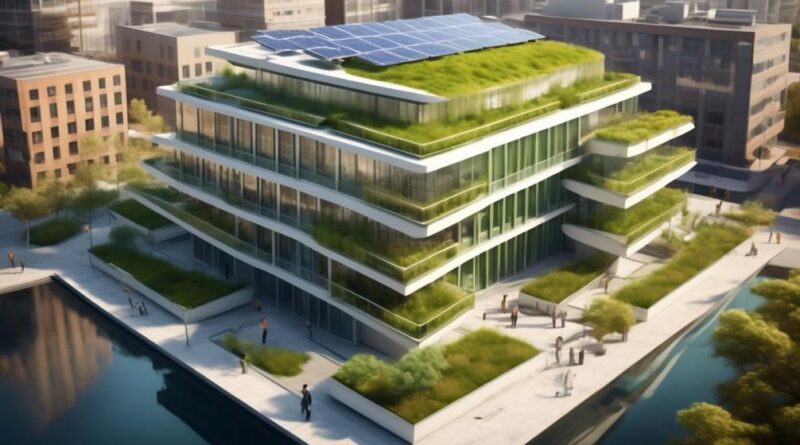What Are the Requirements for LEED Certification?
Considering the captivating concept of sustainable construction, you may be wondering about the requirements for LEED certification.
The process of obtaining this esteemed certification involves meeting specific standards in various categories, each crucial for creating environmentally responsible and efficient buildings.
From sustainable site selection to indoor environmental quality, LEED certification encompasses a comprehensive set of criteria that you'll want to explore further to understand the full scope of what it takes to achieve this esteemed recognition.
LEED Certification Overview
Before starting a LEED certification process, it's essential to understand the overview of what it entails. LEED, or Leadership in Energy and Environmental Design, is a globally recognized symbol of sustainability achievement and is the most widely used green building rating system in the world.
The LEED certification process involves meeting certain green building standards set by the U.S. Green Building Council (USGBC) to ensure that a building or project is environmentally responsible, profitable, and a healthy place to live and work. This process covers various aspects such as energy savings, water efficiency, CO2 emissions reduction, improved indoor environmental quality, and stewardship of resources and sensitivity to their impacts.
To begin the LEED certification process, the first step is to register the project with the USGBC and identify the desired level of certification. The next step involves submitting documentation that demonstrates compliance with the green building standards. This documentation includes detailed information about the building's location, design, materials, water and energy usage, and indoor environmental quality.
After the submission, the USGBC reviews the documentation and provides feedback. Once all requirements are met, the project can achieve one of four levels of certification: Certified, Silver, Gold, or Platinum.
Understanding the LEED certification process and green building standards is crucial for successfully navigating the path to certification and ensuring that your project aligns with sustainable and environmentally friendly practices.
Sustainable Site Selection
When selecting a site for your project, it's crucial to prioritize sustainability and environmental impact. Sustainable site selection is a fundamental aspect of sustainable development and plays a key role in achieving LEED certification. One of the initial steps in sustainable site selection is conducting an environmental impact assessment. This assessment helps in understanding the potential effects of the project on the surrounding environment and allows for the identification of ways to minimize negative impacts.
In sustainable site selection, it's important to consider factors such as the site's proximity to public transportation, availability of bike lanes, and walkability. Choosing a site with access to public transportation and promoting alternative modes of transportation can reduce the project's carbon footprint and contribute to a more sustainable development. Additionally, incorporating green space and preserving natural habitats within the site can enhance biodiversity and mitigate the environmental impact of the project.
Furthermore, sustainable site selection involves evaluating the site's stormwater management capabilities and its potential for sustainable landscaping. Implementing features like rain gardens, permeable pavement, and green roofs can help manage stormwater effectively, reduce runoff, and support the site's overall sustainability.
Water Efficiency Standards
To meet LEED certification requirements, you must adhere to water efficiency standards that focus on reducing water consumption and promoting sustainable water management practices. Water conservation is a key aspect of LEED certification, and achieving this involves the use of efficient fixtures and implementing strategies to minimize water usage.
One way to meet these standards is by installing low-flow fixtures such as faucets, toilets, and showerheads. These fixtures are designed to use significantly less water than traditional ones, thereby reducing overall water consumption within the building.
Additionally, implementing water-efficient landscaping practices can contribute to water conservation efforts. This may include using native or drought-resistant plants that require less irrigation, as well as utilizing efficient irrigation systems that minimize water waste.
Another approach to meeting water efficiency standards is the implementation of water reuse systems. These systems collect and treat greywater from sources such as sinks and showers, making it suitable for non-potable uses like toilet flushing or irrigation.
Energy and Atmosphere Criteria
Implementing energy-efficient systems and utilizing renewable energy sources are key components for meeting the Energy and Atmosphere Criteria in LEED certification. The energy performance of a building is a critical factor in achieving LEED certification. To meet the energy and atmosphere criteria, buildings must demonstrate optimized energy performance through various strategies such as efficient design, equipment, and renewable energy sources.
One way to meet energy and atmosphere criteria is by implementing energy-efficient systems. This can include using high-efficiency HVAC systems, advanced lighting controls, and building automation systems to optimize energy usage. Additionally, incorporating renewable energy sources such as solar panels or wind turbines can significantly contribute to meeting the criteria. These renewable energy sources can help offset the building's energy consumption and reduce its environmental impact.
In order to achieve LEED certification, it's essential to prioritize energy conservation and efficiency. This can be accomplished through the use of energy modeling to assess and improve the building's energy performance. By analyzing the building's energy usage and identifying areas for improvement, developers and designers can implement strategies to increase energy efficiency and reduce overall energy consumption.
Materials and Resources Guidelines
You should prioritize the use of sustainable and recycled materials when seeking to meet the Materials and Resources Guidelines for LEED certification. By incorporating sustainable materials and waste reduction techniques into your building design and construction process, you can help minimize environmental impact and contribute to a healthier, more sustainable future.
- Utilize locally-sourced materials to reduce transportation emissions and support the local economy.
- Choose materials with high levels of recycled content to minimize the need for virgin materials extraction.
- Opt for renewable materials such as bamboo or cork, which have a lower environmental impact compared to traditional materials.
- Implement waste reduction techniques such as salvaging and reusing materials from existing structures or construction sites.
- Prioritize materials with third-party certifications, such as Forest Stewardship Council (FSC) certification for wood products, to ensure sustainable sourcing and production practices.
In addition to utilizing sustainable materials, it's essential to focus on waste reduction techniques throughout the construction process. This includes minimizing waste generation, recycling materials whenever possible, and responsibly disposing of any unavoidable waste. By incorporating these strategies, you can't only improve your building's environmental performance but also contribute to a more sustainable and resilient built environment.
Indoor Environmental Quality
As you consider the sustainable materials and waste reduction techniques for LEED certification, it's crucial to prioritize indoor environmental quality to ensure a healthy and comfortable living or working environment. Indoor environmental quality encompasses various factors, including air quality and thermal comfort, which significantly impact the well-being and productivity of building occupants.
Air quality is a fundamental aspect of indoor environmental quality. To meet LEED certification requirements, it's essential to implement measures that enhance indoor air quality. This can be achieved through the use of low-emitting materials, proper ventilation systems, and regular maintenance to minimize indoor air pollutants. Additionally, incorporating air filtration systems and monitoring indoor air quality levels can further contribute to a healthier indoor environment.
Thermal comfort is another critical element of indoor environmental quality. Adequate thermal comfort ensures that building occupants can maintain a comfortable temperature within the space, promoting productivity and well-being. To meet LEED certification standards, it's important to design and implement heating, ventilation, and air conditioning (HVAC) systems that provide efficient temperature control while minimizing energy consumption.
Prioritizing indoor environmental quality not only aligns with the principles of sustainability but also contributes to creating a space where occupants can thrive. By addressing air quality and thermal comfort, buildings seeking LEED certification can foster a healthier and more comfortable indoor environment for their occupants.
Innovation in Design

To achieve LEED certification, incorporating innovative design features that prioritize sustainability and energy efficiency is essential. Innovation in design is crucial for creating buildings that not only minimize their environmental impact but also enhance the well-being of the occupants.
Here are some key considerations for incorporating innovation into the design process:
- Sustainability Integration: Integrating sustainable materials and technologies into the design can significantly reduce the environmental footprint of a building. This includes using renewable energy sources, implementing water-saving systems, and incorporating recycled or locally sourced materials.
- Energy-Efficient Systems: Embracing innovative HVAC, lighting, and insulation systems can greatly enhance energy efficiency. These systems should be designed to optimize energy usage while maintaining a comfortable indoor environment.
- Creative Space Planning: Creative and thoughtful space planning can maximize natural light, ventilation, and outdoor views, which not only reduces the need for artificial lighting and mechanical ventilation but also enhances the overall occupant experience.
- Adaptive Reuse and Flexibility: Designing with adaptability and flexibility in mind allows buildings to evolve with changing needs, reducing the demand for new construction and minimizing waste.
- Community Engagement: Innovative design should also consider the impact on the surrounding community, fostering connectivity, and promoting sustainable transportation options.
Incorporating innovation into the design process not only promotes sustainability but also fosters creativity and forward-thinking solutions that can positively impact the environment and the people who interact with the built environment.
Regional Priority Credits
Regional Priority Credits are additional points that can be earned in specific geographic regions to address local environmental priorities. These credits are designed to incentivize projects to focus on addressing the unique environmental challenges and priorities of their specific location. By earning these credits, you can demonstrate a deeper commitment to reducing the environmental impact of your project within the local community.
To achieve Regional Priority Credits as part of your LEED certification, it's essential to engage with the local community and understand the specific environmental concerns that are most relevant to the region. This may involve collaborating with local environmental organizations, government agencies, or community groups to identify the most pressing environmental issues that can be addressed through your project.
Frequently Asked Questions
Are There Any Specific Financial Incentives or Tax Credits Available for Buildings That Achieve LEED Certification?
If you achieve LEED certification, there are specific financial incentives and tax credits available for your building. These incentives and credits are designed to reward sustainable and environmentally friendly construction and operation.
How Long Does the LEED Certification Process Typically Take From Start to Finish?
Typically, the LEED certification process takes around 3-5 years from start to finish, depending on the project's complexity. Costs vary based on the building's size and type. It's a thorough and rewarding journey.
What Are the Ongoing Maintenance and Reporting Requirements for Maintaining LEED Certification?
To maintain LEED certification, ongoing maintenance and reporting requirements are essential. You must ensure energy efficiency and sustainable practices are upheld. Regular reporting on these aspects is crucial to maintaining your LEED certification.
Are There Any Specific Requirements for Existing Buildings to Achieve LEED Certification, or Is It Primarily for New Construction?
To achieve LEED certification for an existing building, you need to implement sustainable practices like energy efficiency and water conservation. Regular building maintenance and green initiatives are crucial. It's not just for new construction.
Are There Any Specific Training or Education Requirements for Building Managers or Staff to Maintain LEED Certification?
To maintain LEED certification, building managers and staff must meet specific training and education requirements. These are essential for staying updated on sustainable building practices and ensuring the ongoing implementation of environmentally friendly strategies.
Conclusion
So, if you want to achieve LEED certification, make sure your project meets the sustainable site selection, water efficiency, energy and atmosphere, materials and resources, indoor environmental quality, innovation in design, and regional priority credits requirements.
By meeting these standards, you can contribute to a more sustainable and eco-friendly built environment.
Good luck with your LEED certification process!
